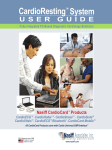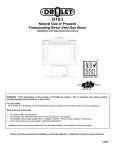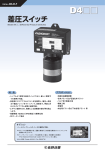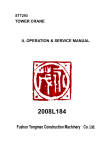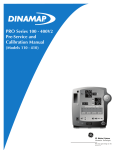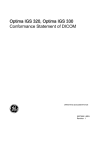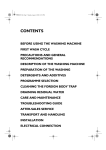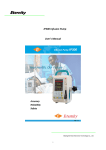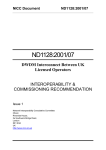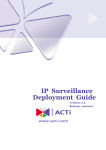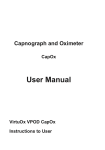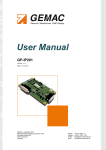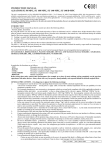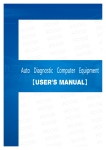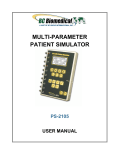Download Patient Monitor Manual Contents
Transcript
Patient Monitor Manual Patient Monitor Manual Patient Monitor Manual Contents Section1 Preface-----------------------------------------------------------------------------( 3 ) Section7 Error Messages and Troubleshooting ---------------------------------------( 39 ) Section8 Maintenance-----------------------------------------------------------------------( 43 ) Section9 Package Transportation and Storage-----------------------------------------( 46 ) Working Environment----------------------------------------------------------------------( 3 ) Security---------------------------------------------------------------------------------------( 3 ) Notice-----------------------------------------------------------------------------------------( 4 ) Section2 General----------------------------------------------------------------------------( 6 ) Usage-----------------------------------------------------------------------------------------( 6 ) General Information-------------------------------------------------------------------------( 6 ) Optional Device-----------------------------------------------------------------------------( 6 ) Accessories ---------------------------------------------------------------------------------( 7 ) Section3 Setup---------------------------------------------------------------------------------( 9 ) Preparations Instructions-------------------------------------------------------------------( 9 ) Turn On the Monitor -----------------------------------------------------------------------( 14 ) Section4 Monitoring Functions Instructions--------------------------------------------( 17 ) ECG Monitoring ----------------------------------------------------------------------------( 17 ) Respiration Monitoring --------------------------------------------------------------------( 20 ) NIBP Monitoring ---------------------------------------------------------------------------( 20 ) SpO2 Monitoring ---------------------------------------------------------------------------( 22 ) Heart/Pulse Rate Monitoring --------------------------------------------------------------( 24 ) ST-Segment Monitoring--------------------------------------------------------------------( 24 ) Temperature Monitoring-------------------------------------------------------------------( 24 ) Section5 Operation Instructions-----------------------------------------------------------( 25 ) Data Setting ---------------------------------------------------------------------------------( 26 ) Abnormal Information ---------------------------------------------------------------------( 30 ) Daily Information --------------------------------------------------------------------------( 32 ) Trend Information --------------------------------------------------------------------------( 33 ) Alarm Mute----------------------------------------------------------------------------------( 34 ) Filter------------------------------------------------------------------------------------------( 34 ) Automatic NIBP----------------------------------------------------------------------------( 34 ) Help------------------------------------------------------------------------------------------( 35 ) Section6 Features and Technical Specifications ---------------------------------------( 36 ) Page1 of 43 1 Page 2 of 43 Patient Monitor Manual Patient Monitor Manual §1.3 Section 1 Preface Notice Your accepting of our production is greatly appreciate, and it is important before you turning on the monitor that we recommend you strongly to read the security clauses and cautions clauses. Please pay attention to the clause where marked ● z Avoid any collision to the equipment because the LCD screen may be heavy damaged. §1.1 ECG Monitoring(All the situation followed may disturb the measure) z Avoid curving the electrode leads or probes in an acute angle or pressing them by rigid material or dragging them .All the action above may cause the electrode leads or probes inside broken or desquamation. Working Environment z Make sure the disposable Ag/Agci snap-on skin electrodes are adopted when the equipment work in the same time with de-trembling. Using other electrode may cause This patient monitor can work in following environment: z Temperature: negative influence to the ECG waveform and slow down the baseline reset, even cumber 10℃~40℃ some of the monitoring function after using de-trembling. z Relative Humidity: 30%~75% z When work with electrosurgical unit, please position the equipment as section §4.1.4 z Atmospheric Pressure: 70kPa~106kPa z Build-in Battery: Li battery z Input Power: described. Otherwise the electrosurgical unit may produce disturbance and disorder 7.4V 2.2A ECG monitoring, causing inaccurate analysis and arrhythmia report. 15VA z Adapter Input Power: z In the situation when the ECG signal is overflow or the electrode lead break off, the AC220V±22V 50Hz equipment will show“electrode lead break off”, at the moment the ECG data displayed §1.2 is already inaccurate. Security z When patient with heart- pacemaker is monitored, asynchronous signal may cause inaccurate ECG data. z Keep the equipment off the flammable gas and oxygen pot, Otherwise some undesirable SpO2 Monitoring(All the situation followed may disturb the measure) results may come out such as exploding. z When the patient is in the situation of shock or cardiac muscle anabiosis, the SpO2 z Avoid using the equipment in the circumstances such as strong magnetic field, measure may be inaccurate because of movement of the patient. coagulable environment, too many dust surroundings and shaking condition. z The data may be inaccurate when HbCo MetHb raise abnormally. z Do not put the equipment in the circumstances where may be sprinkled by water or too z The data may be inaccurate when the equipment works with electrosurgical unit. wet atmosphere. z The data may be inaccurate when the blood is mixed with pigmented material. z If the equipment is sprinkled by liquid, it is imperative that cut off the power z The data may be inaccurate when the pulse waveform is too feeble. immediately and check out the equipment to make sure it is not damaged. z The data may be inaccurate when the probe is damaged. z Make sure the electrodes and temperature probe is insulated with other conductor and NIBP Monitoring earth. z It is noteworthy that some other equipments may cause disturbance and the disturbance z In case of timing interval NIBP Monitoring or consecutive NIBP Monitoring, please could influence the security of the patient through the electrode leads when heart- check the hands ,feet and blood vessel of the patient and make sure the circulation of pacemaker is inspected. blood is in good condition. Page3 of 43 3 Page 4 of 43 Patient Monitor Manual Patient Monitor Manual z Section 2 General All the accessories should use the original accessories from our company, otherwise the performance of the monitor may be reduced. Classification of the Accessories: §2.1 Usage Classification Description Specification Remark Bloodpressure For Baby Width:8cm All the Blood pressure NIBP cuff Temperature, Blood pressure, Respiration and SpO2. §2.2 should be replaced after one year NIBP cuff Patient monitor is competent for the monitoring of the Echocardiograph, Heart Rate, General Information SpO2 Probe For Child Width:10cm For Adult Width:15cm Windpipe Length:2m Type BCI Length:2.5m The Probe should be replaced after one year usage or more than 6000 This equipment include Main Unit, Electrode Lead, Blood pressure NIBP cuff, SpO2 hours operation. Probe, Temperature Probe etc. This equipment is I Class CF Normal Unit, it can resist the disturbance of High Frequency E-knife. This equipment accord with Chinese National Criterion GB9706.25 and §2.3 operation. GB9706.1. Accessories Temperature Heat-Sensibility Length:2m Probe Resistance Electrode Lead CNT04 Length:3m Adapter AC Adapter 12V/2A Battery Li battery 7.4V 2.2 A The battery should be replaced after one year operation or more than 200 periods of recharge. When you open the package of patient monitor, besides the main unit, you can find some accessories as follow: Printer Portable □ 1 Copy of Patient Monitor Manual (Optional) Printer □ An Accessories Package which contains accessories as follow: Printer With the printer § 1 set of 5 Electrodes Lead connection § 1 set of Blood pressure NIBP cuff used for adult cable Length:1m Table 2 § 1 set of SpO2 Probe § 1 set of Temperature Probe with a range of 0~50℃ § 1 of 12V/2A AC Adapter § 30 sets of Attaching Disposable Electrode § 1 set of portable printer(If optional module Printer selected) § 1 set of printer connection cable(If optional module Printer selected) § 1 roll of printer paper(If optional module Printer selected) Page5 of 43 5 Page 6 of 43 Patient Monitor Manual Patient Monitor Manual Section 3 Classification of Consume Material Setup Name Description Manufacturer Remark Attaching Ag/Agci LiTu medical equipment Could Co.,Ltd ShangHai de-trembling §3.1 Operation Instructions of Setup White colour §3.1.1 Instructions of Front Panel Disposable work with Electrode Heat-sensitived Print Paper Φ50*20m Medical printer paper Co.,Ltd TianJin Table 3 Specification of Attaching Disposable Electrode: AC resistance ≤3KΩ De-trembling abnormal voltage ≤100mV Simulated de-trembling reset capability: 5 sec alt spark voltage between probes≤100mV Average change rate in 10 sec ≤1mv/s AC resistance after simulated de-trembling ≤3KΩ Bias current allowance ≤100mV Pic 1 1. PRINT Waveform is printed after pressing this key. 2. FREEZE Waveform is frozen after pressing this key. Pressing again free the frozen waveform. 3. STORE Waveform is stored on the screen after pressing this key. 4. PRESS Blood pressure is measured manually after pressing this key. Pressing again stops this measurement. 5. Four- Pressing four-direction key to move the cursor to the menu. Direction Key 6. Confirm Key Pressing the medial key of the four-direction key to confirm the selection. 7. Power Key Pressing this key to On/Off the monitor. 8. Indicator Indicate the state of power supply. Ligh Page7 of 43 7 Page 8 of 43 Patient Monitor Manual §3.1.2 Patient Monitor Manual Instructions of Right Side Panel NIBP Socket SpO2 Socket Temperature Socket ECG/Respiration Socket Pic 2-A §3.1.3 Transformation Shelf Instructions of Left Side Panel: Hole of Printer Connection Cable The transformation shelf in the back of the monitor is designed for setting of the position of shelves and hanging. In the position of shelves, operator can rotate the shelf to 30 degree and the shelf is automaticly fixed. As Pic 3-A shows. Hole of Adapter Pic 3-A Pic 2-B §3.1.4 Instructions of Back Side Panel In the position of hanging, operator can operate as follow: Step1 Rotate the shelf to 135 degree. Step2 Push the shelf and rotate the shelf to 180 degree. Then the shelf is in the Page9 of 43 9 Page 10 of 43 Patient Monitor Manual Patient Monitor Manual position of hanging. As Pic 3-B shows. Step3 Push the shelf again operator can rotate the shelf to other position. Pic3-B On the Back Side Panel, there are also some appendent interface sockets used for (A) some client with specific demand, so most of the client do not need and may not use these (B) (C) Pic 4-B interface sockets self-determinedly. A. Following the direction of the arrowhead, move the wedged bulge to unlock the cover of the box of Printer Paper. §3.1.5 On-line Printer(Optional) See the details in Pic No.4-B-(A) can work with portable printer with the connection cable: B. Following the Picture, position 1 roll of the Print Paper in the box. Please be cautions that the heat-sensitived side of the Print Paper must face to up. See the details in Pic No.4-B-(B) C. Pull several centimeters of the Print Paper, then close the box. Please notice the lock of the box and make sure it is locked. See the details in Pic No.4-B-(C) Specification of the Print Paper is 50mm×20m. The heat-sensitived side must face to the inside of the box. Please clean the surface of the nozzle of the Printer before changing the Printer Paper. The width of the Print Paper should not wider than the sawtooth of the printer. §3.1.6 Power The Power or de-trembling Power from the battery is applicable to the equipment. The equipment will use AC Power first, the battery in the equipment can be Pic 4-A recharged automatically. When the battery with enough power, the battery will work automatically when the The processing of setup printer paper is as follow: AC Power cut off. This course has no influence to the measure. Page11 of 43 11 The battery can only be recharged by this equipment, and do not cut off the Power Page 12 of 43 Patient Monitor Manual Patient Monitor Manual z during the course of recharging. The whole course of recharging will cost approximately 8 If there is any other trouble, please cope with it following “Section7 Error Messages and Troubleshooting”. hours. Before the situation of storing the battery or first using the battery, please recharge The initial displayed information showed on the screen is in Pic No.5 the battery to the full state, and after more than 1 month of storing, please recharge the battery again before using it. The process of disposing battery: If the battery can only hold less than 0.5 hours, please replace it. The used battery should be disposed appropriately according to the rule of some relevant law. §3.1.7 Necessary preparations before monitoring A. If the battery is needed, please check if the power of the battery is full. B. The key and the switch is in good condition. C. The environment of the equipment is dry. D. The Power cord and all kinds of probes are in good condition. §3.1.8 Necessary back-check after monitoring A. Some settings for temporary situation should be changed to the ordinary setting. B. The Probe and other accessories should be cleaned, disinfected and well stored. C. Clean the dirt on the equipment. D. The battery is in full state. E. After turn off the equipment, please cut off the connection of Power. Window of Alarm: F. The equipment should be stored in the dry environment. Window of ECG: Shows the Heart Rate and VPC. Pic 5 red colour shows alarm, shows dismiss alarm. Window of ST: Shows the real time ST-Segment measurement. §3.2 Turn On the Monitor Window of NIBP: Shows the Blood pressure(SYS/DIA and MEAN) in two forms(Kpa and mmHg). After turning on the monitor, please check the indicator light which means different Window of SpO2: Shows the SpO2 and Pulse Rate. state of the equipment. z Window of RESP: Shows the rate of respiration. Green Colour Retaining: Using Power Window of TEMP: Shows the measurement of temperature. Orange Colour Retaining: Using battery power The functions of menus such as Data Setting, Abnormal Information, Daily Orange Colour Glittering: Recharging the battery Information, Trend Information, Alarm Function, Filters Function, Timing interval NIBP Red Colour Glittering: Low power in the battery Monitoring and Help showed in the bottom of the screen will be instructed in If the indicator light do not work, please check if the Adapter is connected “Section 5 Operation Instructions”. appropriately. Page13 of 43 13 Page 14 of 43 Patient Monitor Manual Patient Monitor Manual breastbone breastbone Midpoint of the line Midpoint of the line between V2 and V4 between V2 and V4 Fifth intercostal space on Fifth intercostal space on the left the left mide-tremblinglavicular mide-tremblinglavicular line line Space between left Space between left anterior 7 Lead signals. The analogous Electrode Lead imitating the person Electrode Lead has the anterior axillary line and axillary line and fifth rib following signals: Standard Electrode Lead(Ⅰ, Ⅱ, Ⅲ), limbs Electrode Lead(aVR, aVL, fifth rib Section 4 Monitoring Functions Instructions C3(White) C4 (White) V3 (Brown) V4 (Brown) ECG Monitoring §4.1 §4.1.1 Selection of Electrode Lead C5 (White) The common method to monitor ECG is using 5 Electrodes Lead, which can obtain V5 (Brown) Fifth intercostal space on Fifth intercostal space on between bosom Electrode Lead and limbs Electrode Lead. The main difference is the the left the left amplitude of the ECG waveform. Changing the position of the Electrode Lead or adopting mide-tremblinglavicular mide-tremblinglavicular the method of limbs Electrode Lead can get more desirable waveform. You can also put line line Above the right side of Above the right side of the the abdomen abdomen C6 (White) aVF) and bosom Electrode Lead(V). There is slight difference of the waveform of ECG the Electrode Lead as following table if you want to get one Lead waveform specially. RL (Black) Definition of the Electrode Lead Mark of Mark of Position of MarkⅠand Position of MarkⅢ and Electrode Electrode aVR aVF Lead Lead (Europe) (International) L A(Yellow) LA (Black) Left anterior axillary line Left supraclavicular fossa R A(Red) RA (White) Right anterior axillary Right anterior axillary line V6 (Brown) RL (Green) line LL(Green) C1 (White) C2 (White) LL (Red) V1 (Brown) V2 (Brown) Space between seventh Space between seventh and and eighth rib on the left eighth rib on the left anterior axillary line anterior axillary line Fourth intercostal space Fourth intercostal space on on the fringe of the right the fringe of the right breastbone breastbone Fourth intercostal space Fourth intercostal space on monitoring could be inaccurate. The Electrode Lead can also be moved to the back side or on the fringe of the left the fringe of the left the buttocks when the position of the Electrode Lead would be in operating. Pic 6 Three Electrode Lead is used in operating room, but the result of Respiration Page15 of 43 15 Page 16 of 43 Patient Monitor Manual Patient Monitor Manual §4.1.2 operation table if it is possible. Position the Electrode Lead The measure of ECG adopts Attaching Disposable Electrode, the position of the Please insert the connector plugs of adapter to the different AC sockets when the electrode would influence the signal of the ECG. Before the electrode is put in right position, equipment works with electrosurgical unit, and try to separate the two AC sockets as far as please keep the skin as clean as necessary. The step is as following: possible. A. Use the rubber rub the skin softly. B. If the patient is lipid-skin, please use alcohol to rub the skin first, after the alcohol is working with electrosurgical unit. Otherwise, the improper connection will harm the skin Please make sure the electrode is stick to the patient firmly when the equipment is evaporated, then execute step A. of the patient. C. Please use the three Electrode Leads measurement to avoid the disturbance. execute step A. Please protect the spare metal part and the temperature probe connected the D. Connect the electrode lead and the electrode. equipment by some insulation method, and make sure the metal part and the temperature E. Uncover the insulation paper on the electrode from the edge. probe is insulated to other metal or ground. Otherwise the patient and the operator may be F. Stick the stickiness side of the electrode to the skin where be rubbed firmly. harmed by lightning. G. Do not stick the electrode to the skin where is not flat. H. If the wave of ECG is disturbed, please check whether the stickiness side of the §4.1.5 electrode is still stickiness or the electrode exceed the time limit. Please warm the position where put the electrode by warm towel in the winter, then Work with de-trembling function When work with de-trembling, the operator should not attach to the patient, the bed and the equipment connected to the patient to avoid to be injured. §4.1.3 Selection of ECG Wave §4.2 This equipment uses the No.1 Lead waveform from theⅡElectrode Lead to monitor to display ECG signal. So the first Lead is set to ⅡElectrode Lead automatically Respiration Monitoring when monitor the ECG. Other Lead can use to display other waveform form Electrode The electrode to monitor respiration and ECG is same. Please put the Black Leads. The No.4, No.5 and No.6 Lead can be set to display the waveform of Blood, Electrode Lead(Marked N)in the position where the fluctuation of the abdomen is SpO2 and Respiration. The detail setting step is shown on §5.1.4. maximum to enhance the sensitivity of the measure. The rate of respiration is displayed on the screen, the data stored can be reviewed in Daily Information, and the Please select the times of amplifying signal appropriately. The times of ECG signal amplifying is 0.5~3.0, you can set to 0.75~1.0 in normal situation. The detail setting wave of respiration can also be displayed on the screen. step is shown on §5.1.5. The monitoring may be inaccurate due the patient’s obesity, because the fluctuation of the abdomen is insensitive or there are only §4.1.4 three Electrode Leads used to measure the respiration. Working with Electrosurgical Unit This equipment can eliminate the disturbance of electrosurgical unit. It can recover to §4.3 the normal state after 10 seconds when the High-Frequency disturbance and magnetic field is eliminated and the data stored is reserved completely. NIBP Monitoring Please possibly position the equipment far away from the electrosurgical unit when The NIBP is measured from the change in amplitude pattern of pulsatile oscillation work with electrosurgical unit. Please put the equipment to the opposite side of the in NIBP cuff pressure as the NIBP cuff pressure is reduced from above systolic to below Page17 of 43 17 Page 18 of 43 Patient Monitor Manual Patient Monitor Manual diastolic pressure. The occlusive-oscillometry method uses this to determine the systolic, than heart, the result of NIBP can add 2mmHg by each inch(or 0.1kPa each centimeter); if diastolic, and mean arterial pressure. the NIBP cuff lower than heart, the result of NIBP can reduce 2mmHg by each inch(or 0.1kPa each centimeter). The systolic pressure is the pressure at which the pulsatile oscillation suddenly The measured data could be influenced by some kinds of medicine. The result of increases, and the diastolic pressure is the pressure at which the pulsatile oscillation suddenly decreases. The mean arterial pressure is the point where maximum pulsatile NIBP may be inaccurate to the patient who is in the situation of hyperkinesia oscillation occur. §4.3.2 The measure of NIBP of this equipment adopt more advanced method which is one-step method. According to this method the precision of the measure can be Manual NIBP Monitoring Pressing key of “PRESS”, manual measure NIBP would work on. The equipment enhanced and the measure time can be reduced to two thirds. can complete task of charging air, measuring blood pressure and exhausting. The time of measuring is about 15~40 seconds. All the process can be terminated by pressing key of §4.3.1 Step of NIBP Monitoring “PRESS” again. A. Connect the air hose to the socket of NIBP on the equipment. Please make sure that the connection of the air hose and the socket is firm.(You can in the NIBP cuff have been exhausted completely. Time between two measurements should longer than 40 seconds to make sure the air heard a sound of “Ka”, if you insert the air hose correctly.) Otherwise, the NIBP cuff may not work properly, the leaking air may lead to incorrect data or the failure of measurement. B. §4.3.3 The position of the NIBP cuff is that the bottom of the NIBP cuff should above the Please set the interval of the two measurements(ranged 1minute to 240 minute) if in the mode of automatic NIBP Monitoring. The detail setting method is shown on §5.2.3. elbow more than 1cm~2cm, and the sign of the NIBP cuff should be in the artery of the inside arm. Automatic NIBP Monitoring Startup Automatic NIBP Monitoring: You can press the “BP AUTO” key on Front Please take off the overclothes and the sweater to make sure the accuracy of the NIBP Panel or the “BP Timing” in the bottom of screen to startup Automatic NIBP Monitoring. measure. Then, the message “BP Timing” and the countdown time will be displayed on the top of the C. screen. When the countdown time shows zero, the Automatic NIBP Monitoring will start The NIBP cuff should keep close to the arm and the interspace between them should not be more than one finger space. automatically. Do not tight the NIBP cuff too tight or too loose. Too tight may cause the patient Stop Automatic NIBP Monitoring: You can press the “BP AUTO” key on Front Panel uncomfortable and lead the data measured low than the normal dare; too loose may cause or the “BP Timing” in the bottom of screen again to terminate Automatic NIBP Monitoring. longer measure time and lead the data measured high than the normal data. Please check the function of automatic NIBP monitoring whether it is on or the Please keep the air hose away from patient and bed to avoid inaccurate measure. automatic timing is zero, if the NIBP cuff is not colligated. Measuring with the not well The air hose should not be folded or twisted. colligated NIBP cuff will damage the monitor. Please check the NIBP cuff and colligate it again every 8 hours to make sure the blood can flow fluently. D. §4.4 The patient’s arm should lay on the table and palm face to up, the NIBP cuff should at the same level with heart, if the patient is in the situation of sitting. SpO2 Monitoring SpO2 is monitored by attaching a probe to the patient and using the SpO2 socket on Operator can revise the measured data as following method: If the NIBP cuff higher Page19 of 43 the monitor. 19 Page 20 of 43 Patient Monitor Manual Patient Monitor Manual §4.4.1 A. Step of SpO2 Monitoring Connect the probe to the SpO2 Socket of the equipment. Please confirm the SpO2 Probe is connected correctly and firmly(You can hear a (A) sound of “Ka” if you connect correctly). B. §4.5 forefinger is just facing the position of the clamp where is emitting the red light.(See in Pic No.7(A)) Heart/Pulse Rate Monitoring Heart Rate monitoring is according to the waveform of ECG, and is displayed in the Other finger could be used to monitor SpO2 if the forefinger is unsuitable. ECG window. Please do not put SpO2 probe to the limb where is used for NIBP monitoring. Pulse Rate monitored is according to the waveform of SpO2 measurement, and is Please press the flank of the clamp-liked probe to make it attach to the patient firmly. displayed in the SpO2 window marked PR. The wire of the probe should follow the direction of arm. (See in Pic No.7(B)) D. (C) Pic 7 Wait for the red light twinkling several times(about several second). Then open the clamp-liked probe, clamp the forefinger. Please make sure the root segment of nail of C. (B) The probe and wire can be wrapped by adhesive tape to reduce the disturbance.(See §4.6 in Pic No.7(C)) Please check the skin clamped by the probe every 4 hours, and change other finger to ST-Segment ST-Segment monitoring is displayed in the ST-Segment window with 3 Leads of monitor SpO2. ST-Segment measurement. The alarm of ST-segment is controlled according to the data Measurement may be incorrect in the following case: measured in The No.1 Lead ECG waveform. The colours of the ECG Lead are When the patient’s carboxyhemoglobin or methemoglobin increases abnormally. corresponded to those showed in the ST-segment window. When using an electrosurgical unit. When dye is injected in the blood. §4.7 When there is body movement. When there is vibration. Temperature Monitoring Temperature is monitored by attaching temperature probe to the skin of the patient. When measuring at a side with venous pulse. Please connect the probe to the temp socket on the equipment and wrap the probe by When the pulse wave is small(insufficient peripheral circulation). adhesive tape to make sure it attach the patient firmly. When using an IABP(intra-aortic balloon pump) The temperature measurement is displayed in the TEMP window. In the situation of strong light, please cover the probe with a opaque paper or fabric to ensure the correct measurement. Page21 of 43 21 Page 22 of 43 Patient Monitor Manual Section 5 Patient Monitor Manual D. Operation Instructions PRESS: Operator can start the Manual NIBP Monitoring by pressing this key, and one more press will terminate the NIBP monitoring immediately. Operator can select each menu by pressing four-direction key. Operator can also confirm the selection by pressing confirm key. There are several menus on the menu showed in the bottom of screen and 4 keys on the front panel. Operator can use four-direction key and confirm key to enter each §5.1 secondary menu and setup the detail setting. Data Setting The functions of menus are described as follow: Data Setting(Showed Data Set for short in screen): Operator can modify the date Selecting the secondary menu Data Setting in the Main menu can enter the menu setting, selection of waveform and colour showed in each Lead, times of amplifying, showed as follow. Operator can modify the date setting, selection of waveform and colour speed of scanning, automatic NIBP timing and alarm setting. showed in each Lead, times of amplifying, speed of scaning, automatic NIBP timing and B. alarm setting. A. Abnormal Information(Showed Abnormal for short in screen): Operator can The manufacturer default setting of parameters is showed as follow: review the abnormal data waveform and record of ECG. C. Daily Information(Showed Daily Data for short in screen): Operator can review the daily data by index. D. Trend Information(Showed Trend for short in screen): Operator can check the data of ECG, NIBP, SpO2, Temperature and Respiration by chart. E. Sound Off: Operator can start/terminate the function of alarm. F. Filter: Operator can start/terminate the function of filter. G. Automatic NIBP(Showed BP Timing for short in screen): Operator can start/terminate the function of automatic NIBP. H. Help: Operator can read the E-document of helping stored in the equipment. I. Volume: The volume menu on screen can control the volume. Operator can press four-direction key to move the cursor until the colour of “ ”is changed(The Volume cursor is just on the right of BP-Timing cursor or on left of Help cursor). Then press confirm key entering the state of changing volume. Operator can press four-direction key Pic 8 to change the volume. Pressing confirm key again to exit. The functions of 4 keys on the front panel are described as follow: A. §5.1.1 PRINT: Operator can print the waveform of real time, abnormal and the Trend Steps of Data Setting Information by pressing this key. A. B. to confirm the selection. Then the option will turn glittering which means this option is in FREEZE: Operator can freeze the real time waveform by pressing this key, and Pressing four-direction key to make the cursor to the option and press confirm key can also dissolve the freezing waveform by pressing again. the state of setup. C. B. STORE: Operator can store the real time waveform to memory manually. Page23 of 43 23 Pressing four-direction key again to increase or decrease the data of this option and Page 24 of 43 Patient Monitor Manual Patient Monitor Manual rhythm, Tirgeminal rhythm, RonT, VTAC, Escape Beat, Sinus arrest and Lost lead. press the confirm key again when the data is desirable. Then the option will stop glittering. C. Selecting the return option showed in the main menu in the bottom of screen can §5.1.8 return to the monitoring state. Range of Alarm Setting Operator can set the upper limit and lower limit of normal parameter as follows: §5.1.2 Setting Bed Number and Date Setting the date and bed number. §5.1.3 Setting the timing of automatic NIBP monitoring The timing of NIBP monitoring ranged from 1 minute to 240 minute, and operator can terminate automatic NIBP monitoring by setting timing of 00 minute. §5.1.4 Select the ECG waveform and other waveform in each Lead A. Upper limit and lower limit of Heart Rate B. Upper limit and lower limit of NIBP C. Upper limit of Temperature D. Lower limit of SpO2 E. Upper limit and lower limit of ST Segment F. Upper limit of VPC G. Upper limit of RonT H. Upper limit of VTAC Operator could change settings for different patient. The detail description of each Operator can set each Lead for displaying different waveform. Except Lead No.1 must display the ECG Electrode Lead Ⅱ, other Lead can choose the Ⅰ, Ⅱ, Ⅲ, aVR, Alarm Setting is as follows: aVL, aVF, V Electrode Lead of ECG or the waveform of Blood pressure, SpO2 and A. Respiration. Operator can choose the colour and painting of each Lead. Alarm for the overstepping of the upper limit and lower limit of Heart Rate The workable range of Heart Rate measure and alarm is 30~250 times/min. The initial alarm setting is upper limit as 120 times/min, lower limit as 30 times/min. §5.1.5 B. Setting the scale of amplifying Each ECG Electrode Lead can be amplified to 0.5, 0.75, 1.0, 1.5, 2.0 and auto, Alarm for the overstepping of the upper limit and lower limit of NIBP The workable range of NIBP measure is 10mmHg~280mmHg. operator should select a proper scale to ensure the waveform of ECG is suitable. The workable range of NIBP alarm is 50mmHg~250mmHg and the alarm is available according to the systolic pressure’s change. §5.1.6 Setting the speed of scanning The initial alarm setting is upper limit as 140mmHg, lower limit as 75mmHg. C. Operator can set the ECG scanning speed to 12.5 ㎜/s, 25 ㎜/s or 50 ㎜/s. Alarm for the overstepping of the upper limit of Temperature The workable range of Temperature measure is 32℃~43℃ and the result of §5.1.7 Alarm Setting temperature measurement may be changed according to the position of temperature probe There are 3 level of alarm setting Level 1: in different part of body. Alarm for the abnormity of Heart Rate(Tachycardia and Bradycardia) and The workable range of Temperature alarm is 32℃~43℃. NIBP. Level 2: The initial alarm setting is upper limit as 38℃. Alarm for the abnormity of Heart Rate(Tachycardia and Bradycardia), NIBP, D. Alarm for the overstepping of the lower limit of SpO2 SpO2 and ST Segment(ST Elevation and ST Depression). The workable range of SpO2 measure is 40%~99%. Level 3: The workable range of SpO2 alarm is 50~99%. Alarm for the abnormity of Heart Rate(Tachycardia and Bradycardia), NIBP, Temperature, SpO2, ST Segment(ST Elevation and ST Depression), VPC, Bigeminal Page25 of 43 The initial alarm setting is lower limit as 95%. 25 Page 26 of 43 Patient Monitor Manual E. Patient Monitor Manual The menu of Abnormal Information is showed as Pic No.9. Alarm for the overstepping of the upper limit and lower limit of ST Segment The unit of ST Segment is mv, and 0.1mv correspond to 1mm. The workable range of ST Segment alarm is ±0.5mv. The initial alarm setting is upper limit as +0.2mv, lower limit as –0.1mv. F. Alarm for the overstepping of the upper limit of VPC The unit of VPC is times/min. The workable range of VPC alarm is 1~50 times/min. The initial alarm setting is upper limit as 1 time/min. G. Alarm for the overstepping of the upper limit of RonT The workable range of RonT alarm is 1~5times. The initial alarm setting is upper limit as 1 time. H. Alarm for the overstepping of the upper limit of VTAC. Description of VTAC: 3 VPB sequently happen. The workable range of RonT alarm is 3~50times. The initial alarm setting is upper limit as 3 times. I. Alarm for the Escape Beat. Pic 9 Description of Escape Beat: No QRS complex in 2 normal R-R interval. J. K. This equipment can detect 10 kinds of abnormal ECG signal. The limit of each Alarm for the Sinus arrest abnormal ECG signal can be modified in §5.2 Data Setting. Monitor will automatically Description of Sinus arrest: Longer than 2 seconds with no QRS complex. store abnormal data according to the limit setted in the Data Setting. If there are sequent Alarm for the lost lead. abnormal waveforms occurred, equipment will store the similar waveform by every 10 Description of lost lead : After 10 seconds of electrode lead loose or too much noise minute. preventing analysis, the alarm will sound. This monitor can distinguish Arrhythmia Alarms of Tachycardia, Bradycardia, VPB, The alarm will work when one or more problems happen. Message will be displayed SVPB, VTAC, RonT, Escape beat, Sinus arrest, bigeminy and trigeminy. in the screen to indicate the kind of alarm and sound will remind the operator. Sound alarm Memory can store 64 waveforms of ECG abnormity. Each waveform of ECG will end after 1 minute, but the message will still hold on. If the alarm problem continues, abnormity marks the happening time cause, and the waveforms of ECG abnormity is the sound alarm will work again after 10 minutes. The next alarm problem will replace the showed by index of table convenient for reviewing. If the memory is full filled, the new message of previous one displayed in screen. The sound and message alarm could be coming waveform of ECG abnormity will replace the earliest one. Equipment will store terminated only when all the alarm problem is resolved. each waveform of ECG abnormity for 10 seconds and only the Lead No.1 waveform can be stored. The abnormity normally occur in the 7th second of each stored waveform. §5.2 Operator can review each waveform by selecting the option showed in the bottom of Abnormal Information screen. Equipment also store the data of Heart Rate, VPC, ST Segment, SpO2, Pulse Rate, During the monitoring, equipment can automatically store abnormal data. Page27 of 43 Blood pressure and the Temperature when the abnormal ECG waveform stored. 27 Page 28 of 43 Patient Monitor Manual Patient Monitor Manual Pic 10 Operator can also print the abnormal waveform by press print key. §5.2.1 Operator can print the daily information by press print key. Menu of Abnormal Information §5.3.1 In the state of Abnormal Information, operator can see several keys in the bottom of Menu of Daily Information In the state of Daily Information, operator can see several keys in the bottom of the the screen as showed in Pic No.9. screen as showed in Pic No.10. The functions of the keys are described as follow: The functions of the keys are described as follow: A. Page Up and Page Down keys are used to let operator scan the Abnormal Data B. Up and Down keys are used to let operator select the option A. Page Up and Page Down Keys are used to scan the Daily Data. C. Display Waveform and Next Waveform keys are used to show stored waveform. B. 1 Min, 5Min, 15Min Keys are used to fast scan the Daily Data. D. Reset key used to clean the stored data if the equipment monitor a new patient. Please C. Demo Key is used to display Demo Waveform. Press this key again can terminate the be cautions that if operator select this key, all the Abnormal Data, Daily Data, Trend Demo State. Information and Range of Alarm Setting are recovered to the initial state. D. E. Switch key used to switch the ECG Waveform No.1 and ECG Waveform No.3. F. Return key used to return to the monitoring state. §5.2.2 §5.4 Return Key is used to return the monitoring state. Trend Information Daily Information Seven kinds of monitoring data(Heart Rate, NIBP, SpO2, Temperature, ST Segment, Monitor can display 96 hours’ Daily Data by every minute. The Daily Data contain VPC and Respiration Rate) can be showed in the state of Trend Information. The demo the Date, Time, HR(Heart Rate), VPC, ST Segment, SpO2, PR(Pulse Rate), SYST(systolic chart of NIBP is showed in the Pic No.11. The ordinate means the value of blood pressure; pressure), DIAS(diastolic pressure), MEAN(mean arterial pressure), RR(Respiration Rate) the abscissa means the time. The Chart can present daily data by ways of 6 hours, 24 hours and TEMP(Temperature). They are showed in Pic No.10. and 96 hours. Page29 of 43 29 Page 30 of 43 Patient Monitor Manual Patient Monitor Manual §5.8 Pic 11 §5.4.1 Menu of Trend Information Operator can read the E-document of Help stored in the equipment by selecting this In the state of Chart of Daily Data, operator can see several keys in the bottom of the option. The E-document shows the detail instruction of all the operation which convenient screen as showed in Pic No.11. A. Help The functions of the keys are described as follow: for the operator. Operator can read the instruction by page, chapter or Auto Scan. Select Heart Rate, NIBP, SpO2, Temperature, ST Segment, VPC and Respiration Rate keys return key to return monitoring state. are used to display relevant chart. B. 6 hours, 24 hours and 96 hours keys are used to show chart by different interval. C. Return key is used to return the monitoring state. §5.9 Print Real Time Print: The displaying waveform in the Lead No.1 and No.3 is printed by §5.5 press the “PRINT” key on the front panel. Alarm mute Abnormal waveform Print: The abnormal waveform in the Lead No.1 and No.3 When this option is selected, the alarm function of sound reminding is terminated and stored in memory is printed by press the “PRINT” key on the front panel. when the key is pressed again the function is restarted. When the alarm is mute, the mark Operator should enter the Abnormal Information menu first, then select the option of of “ ” will show on the top-right of screen. When the alarm sound is available, the mark “Display Waveform”. After the abnormal waveform is showed, operator can press the of “ ” will show on the top-right of screen. The classification of alarm is described in “PRINT” key and print the abnormal waveform. §5.1.7 and §5.1.8 Chart of Daily Date Print: The Chart of Daily Date Print is printed by press the “PRINT” key on the front panel. §5.6 Operator should enter the Chart of Daily Date menu first, then select the different Filter option such as Heart Rate, NIBP, SpO2, Temperature, ST Segment, VPC and Respiration Rate. After the chart is showed, operator can press the “PRINT” key and print the relevant When this option is selected, the filter function is available and when the key is pressed again the function is terminated. Filter function is used to reduce the disturbance of chart. AC signal which hinder the ECG signal. The mark of “Filter” will show on the top of the screen when the function is open. should be considered: whether the print paper is used out; whether the cover of printer is If the printer does not work after Operator presses the “PRINT” key, some situation closed correctly. §5.7 Automatic NIBP Please rip the printed paper upward to avoid locking paper. Select this option start the Automatic NIBP function and press again terminate the function. Selecting this option is the same as pressing the “BP AUTO” key on the front panel. When the timing is 0, the NIBP measurement will start automatically. The detail setup of Automatic NIBP is described in §5.1.3 and §4.3.3. Page31 of 43 31 Page 32 of 43 Patient Monitor Manual Section 6 Patient Monitor Manual Features and Technical Specifications Measure Method: Advanced One-step Method with Automatic / Manual Measurement Safety: Accord with Standard GB9706.25 and GB9706.1 Measure Unit: mmHg and kPa Resist electric shock: Class I Class CF Measure Apply to: MEAN(mean arterial pressure) Adult, Child, Baby parameter: SYST(systolic pressure), Size of Screen: 6〞TFT Colour LCD Measure Range: 10mmHg~280mmHg; Resolution: Precision of NIBP: ±5mmHg;±0.7kPa Display Waveform: 4 Leads Display waveforms of ECG, Respiration, NIBP and Protection of Over Pressure: <330mmHg;<44.0kPa Alarm: SYST, DIAS, MEAN 640*480 SpO2 Colours of Waveform: 15 Kinds Freeze Waveform: Available Monitor Functions: Heart Rate, VPC, Three Level ST Segment, NIBP, SpO2, Pulse §6.3 Rate, Respiration Rate and Temperature. §6.1 ECG Input: 5 Electrode Leads RA, LA, RL, LL, C (V1~V6) Electrode Lead: StandardⅠ, Ⅱ, Ⅲ; Body Electrode Lead aVR, aVL, aVF; Bosom 1.3kPa~37kPa SpO2 Range of SpO2 Measurement: 40%~99% Precision of SpO2: Within 85%~99%:±2% ; Within 60%~85%:±4% Alarm Range: 0~99% Measure Pulse Rate Range: 30 Times/min~200 Times/min Precision of Pulse Measurement: ±5% §6.4 Electrode Lead V1~V6 Temperature Time of Signal Amplifying: 0.5, 0.75, 1.0, 1.5, 2.0 Range of ECG Measurement: 30 times/min~250 times/min Measure Range: 32℃~43℃ Precision of ECG: ±5% Precision of Temperature Measurement: ±0.3℃ Scan Speed: 12.5mm/s, 25mm/s, 50mm/s Real Time ECG Analyse and Review: Available Range of Alarm: 30 times/min~250times/min Mode of Alarm: Sound and Screen Remind Alarm, can review Measure Range: 4 Times/min~120 Times/min Work with electrosurgical unit: Available Precision of Respiration Measurement: ±2 Times/min Work with de-trembling: Class CF Sustain 4000VAC/50Hz electric shock §6.2 NIBP §6.5 §6.6 Page33 of 43 33 DIAS(diastolic Respiration Waveform Display Waveform Display: Display 4 Waveform in screen. Page 34 of 43 pressure), Patient Monitor Manual Patient Monitor Manual Trend Information: Store 96 hours chart of data of Heart Rate, NIBP, SpO2, Section 7 Temperature, Respiration, VPC and ST Segment. Store ECG Waveform: Store 64 waveforms of ECG by every 10 seconds. Can freeze the waveform. §6.7 Error Messages and Troubleshooting Cautions:Operator should not open the equipment except manufacturer. Sort Problem Cause Solutions No ECG Electrode is not Check the position of electrodes, Waveform positioned especially check the place of electrode (Only one correctly leadⅡ. Alarm Message for the abnormal system alarm of lost lead or too much noise. Message for the abnormal data alarm of Heart Rate(Tachycardia and Bradycardia), NIBP, Temperature, SpO2, ST Segment(ST Elevation and ST Depression), VPC, Bigeminal The detail position and colour of line) rhythm, Tirgeminal rhythm, RonT, VTAC, Escape Beat and Sinus arrest. Ways of Alarm: Sound and message in the screen. Alarm Level: 3 levels §6.8 electrode lead is shown in §4.1.1 Selection of Electrode Lead. Print(Optional) ECG Abnormal Print: 2 Leads abnormal ECG waveform and he data of Heart Rate, NIBP, Trend Information Print: The Chart of Heart Rate, NIBP, SpO2, Temperature, Noise Respiration, VPC and ST Segment is printed. Page35 of 43 positioned the electrode. correctly B. See the instruction of positioning Check whether the electrode is Patient’s skin is C. not with the mucus on the electrode. cleaned completely. SpO2, Temperature, Respiration, Pulse Rate and ST Segment is printed A. dry. Real Time Print: 2 Leads ECG waveform and the data of Heart Rate, NIBP, SpO2, Temperature, Respiration, Pulse Rate and ST Segment is real time printed. Electrode is not 35 Page 36 of 43 Check whether the alcohol react Patient Monitor Manual Patient Monitor Manual (Waveform A. If patient wear chemical fibre is disorder) underclothes in dry weather, please Patient movement A. The patient should be silent during the course of measuring. Patient’s check whether these clothes will cause Wrong usage of A. Please make sure the root segment disturbance disturbance. Operator probe of nail of forefinger is just facing the cotton-made towel or could use gauze to position of the clamp where is emitting separate the skin and clothes if the red light. necessary. B. Please do not put SpO2 probe to the B. In summer, sweat may cause the limb electrode floating. Please check and press the electrode to SpO2 avoid Patient movement disturbance. Too strong light replace the electrode. for NIBP A. The patient should be quiet during A. Avoid the light irradiate the probe directly. A. Operator should take some steps to Electromagnetism restrain or keep away from the source field disturbance of electromagnetism field. Temperature B. Open filter function. No result C. Do not use one electrical outlet with Respiration this equipment and electrosurgical No result in good condition or replace the NIBP White cuff. display B. Check the socket of NIBP cuff or no result connecting to the equipment. Wrong usage of A. Please check the NIBP cuff and NIBP cuff colligate it again every 8 hours. Battery NIBP cuff suit for adult child or baby. Page37 of 43 function defect function defect. Lost of the probe A. Check the probe. Wrong place of A. Check the selection of electrode electrode lead and the place of electrode. or selection light not work or after 10s 37 Page 38 of 43 Battery A. Connect the equipment to AC is exhausted Power and recharge the battery for 10 minute. screen extinguished level with heart. A. Check the NIBP cuff whether it is in Indicator B. The NIBP cuff should at the same Wrong Size of A.Take steps to avoid haemoglobin of electrode lead A. Check the NIBP cuff whether it is Error result Haemoglobin wrong unit. NIBP used the course of measuring. C. If the situation continues, please Leaking air。 is monitoring. Error result or no result where Patient Monitor Manual Patient Monitor Manual Power No display no Indicator electrical outlet light not work or power in A. Check the electrical outlet whether Section 8 it is with 220V Power. §8.1 Maintenance Cleaning and Disinfecting extinguished after 10s Printer A. Clean equipment after use Locking paper or A. Rip the printed paper upward to Please turn off the equipment and cut off the Power before cleaning. Then clean the surface no paper. avoid locking paper. of the monitor with a soft cloth moistened with neutral soap, water or alcohol(>70%), and B. Close the cover of printer in right wipe with a dry cloth or gauze. Operator should notice that only dry cloth or gauze can be Not work step. used to wipe the screen. Remove dust from the vent holes on the panels with a cotton swab. C. Replace the print paper and make B. sure the side of hot-sensitive face to Clean the accessories after use every time with a soft cloth moistened with neutral soap, up. water or alcohol(>70%), and wipe with a dry cloth or gauze. Clean and disinfect accessories(Electrode Lead and Probe) Disinfect the accessories with a non-abrasive cloth moistened with disinfectant and use Table 5 appropriate concentration. C. Clean and disinfect accessories(NIBP cuff) Please take out rubber in the NIBP cuff carefully. Then clean the cloth-coat with neutral soap. Please clean the surface of rubber in the NIBP cuff and the air hose with a soft cloth moistened with alcohol(>70%). Then dry them sufficiently. Avoid use ultraviolet radiation, ozone or high pressure disinfection to the rubber and air hose. Avoid water flow into the inside of the air hose. Operator should avoid the air hose dipping in the water, otherwise the remain water may cause inaccuracy of NIBP measurement seriously. D. Disposing of used accessories Please dispose the used accessories follow the rule of disposing medical castoff made by the local government. E. Disinfecting of the equipment Monitor could be disinfected by ultraviolet radiation disinfection by 30 minutes. Page39 of 43 39 Page 40 of 43 Patient Monitor Manual Patient Monitor Manual Measurement accuracy is within the specified range. Maintenance §8.2 §8.2.3 the safety and accuracy of measurement of the equipment. condition. §8.2.1 Period Inspection Please check and verify the monitor every year by professional operator to make sure Please maintain the equipment periodically to keep your monitor in optimum Inspection before/after Use Please check the following items before turning on the power of the equipment: Check the probe lead and sensor whether they are lost or the NIBP cuff and air hose are leaking air. Check the electrical outlet and Power cord whether they are in good condition. Keep all the keys, switches and sockets in good condition. Check the settings whether is correct. Please check the following items after every use: Clean and disinfect the probe and lead after every use. Position the equipment to the place where is dry and clean. §8.2.2 Yearly Inspection Please check the following items every year periodically: Monitor is not dirty, damaged or rusty. No key or switch is broken. No damage to the socket of the monitor. Power cord is not damaged. Screen is clean. Screen display is correct. Clock is correct. Settings are correct. The specified electrodes, sensors and probes are used. Printer module operates properly when used. The recorded data are correct. No current leakage. Supplied voltage is correct Page41 of 43 41 Page 42 of 43 Patient Monitor Manual Section 9 Package Transportation and Storage Package §9.1 §9.1.1 Monitor is packed with paper-made container, plastic foam and plastic bag. §9.1.2 Your can find the certification of checkout, user manual and list in container. §9.1.3 Conditions for transportation and storage: Environment Temperature: -10℃~40℃ Range of Relative Humidity: <95% Range of Atmospheric Pressure: 50.0 Kpa~106.0 Kpa §9.1.4 §9.1.5 Indication on package for transportation and storage: Upwards Should not inverse the package. Keep Dry Please store the package in dry environment. Be Careful Please carefully transport the package. Size and weight of package: Size: 260×210×200 §9.2 Weight: 2Kg Transportation Carefully transport the package by truck, train or airplane and avoid rain pouring and sun irradiation. §9.3 Storage Store the packed monitor in clean, dry and well ventilated room. Page43 of 43 43






















